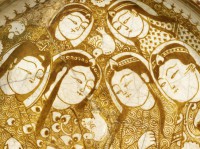Islamic Ceramics trail
Explore over one thousand years of development in Islamic ceramics through our extensive collection.

Collection trails: 1 object
- Reference URL
Actions
Bowl with sgraffito decoration
-
Details
- Associated place
- Date
- 10th century (AD 901 - 1000)
- Material and technique
- earthenware, with decoration incised through a white slip and colours painted in the glaze
- Dimensions
-
6.5 cm (height)
22.5 cm (diameter)
at foot 10.4 cm (diameter)
- Material index
- Technique index
-
- Object type index
- No. of items
- 1
- Credit line
- Gift of Gerald Reitlinger, 1978.
- Accession no.
- EA1978.1759
-
Further reading
Allan, James W., Islamic Ceramics, Ashmolean-Christie's Handbooks (Oxford: Ashmolean Museum, 1991), no. 5 on p. 12, illus. p. 13
Glossary (3)
earthenware, glaze, slip
-
earthenware
Ceramic material made of clay which is fired to a temperature of c.1000-1200⁰c. The resulting ceramic is non-vitreous and varies in colour from dark red to yellow.
-
glaze
Vitreous coating applied to the surface of a ceramic to make it impermeable or for decorative effect.
-
slip
A semi-fluid clay applied to a ceramic before glazing either to coat the surface or for decorative effect.
Location
-
- currently in research collection
Objects are sometimes moved to a different location. Our object location data is usually updated on a monthly basis. Contact the Jameel Study Centre if you are planning to visit the museum to see a particular object on display, or would like to arrange an appointment to see an object in our reserve collections.
Publications online
-

Islamic Ceramics
‘Sgraffito’ comes from the Italian sgraffire, ‘to scratch’, and refers to the technique, common in Islamic pottery, whereby the object is covered with a thin clay slip, and the design is then incised through the slip before the glaze is applied. If, as on this example, the body of the pot is buff, the slip white, and the glaze virtually colourless, the incised lines will appear a buff colour against the white ground.
In the centre of this bowl the potter incised a six-petalled rosette within a hexagon. He slightly misjudged the eight-pointed star pattern he had in mind for the sides of the bowl, and drew nine instead: each contains a briefly sketched bird. The coloured splashes, in iron brown and copper green, were perhaps intended to complement the octagon, but end up by creating their own emphases. The result is poorly integrated, and seems to hang together more by chance than design. Such a loose style was, however, very popular in the Islamic world, and the overall effect of the bowl is quite delightful.
Sgraffito wares of this type came into fashion in Iraq and Iran in the tenth century. Less demanding artistically and technically than those painted with cobalt blue designs or lustre, they provided the decorative glazed wares for large numbers of less affluent town and village dwellers, and formed a ceramic underworld which continued for centuries.
© 2013 University of Oxford - Ashmolean Museum





